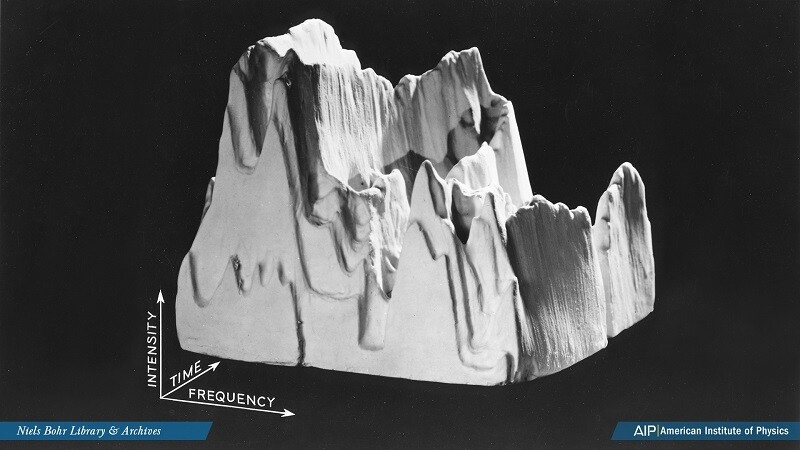
Credit: Bell Laboratories / Alcatel-Lucent USA Inc., courtesy AIP Emilio Segrè Visual Archives, Physics Today Collection
Back by popular demand, Zoom backgrounds, part two! (Check out part one here!

Credit: Bell Laboratories / Alcatel-Lucent USA Inc., courtesy AIP Emilio Segrè Visual Archives, Physics Today Collection
Bell labs sound model of digit five: Solid sound model of the digit ‘five’ - a three dimensional representation of time, frequency, and intensity of the sound, based on a two-dimensional spectrograph tracing.
Image information: Bell Labs H3

Credit: AIP Emilio Segrè Visual Archives
Melba Phillips and Herman William Koch eating ice cream at the AIP Corporate Associates Meeting in 1982.
Image information: Phillips Melba C6

Credit: Digital Photo Archive, Department of Energy (DOE), courtesy of AIP Emilio Segrè Visual Archives
The Los Alamos Central Computing Facility (CCF) in the late 1970s. What looks to be a groovy high-back circular piece of furniture is actually a supercomputer called CRAY-1, which Los Alamos outbid Lawrence Livermore National Laboratory to get in 1976.
Image information: Los Alamos F1

Credit: Photograph by Samuel Goudsmit, Brookhaven National Laboratory, courtesy AIP Emilio Segrè Visual Archives, Goudsmit Collection
Alsos Intelligence Officers: Michael Perrin (British), Samuel Goudsmit, Colonel John Lansdale, Jr. (US), and Commander Eric Welsh (British) searching for Uranium at Haigerloch, Germany, 1945. Image information: Goudsmit Samuel H4

Credit: University of Illinois Alumni Association Archives, courtesy AIP Emilio Segrè Visual Archives.
Professor Abraham H. Taub and Professor Ralph E. Meagher examine an ILLIAC I tape. ILLIAC I, a supercomputer built at the University of Illinois. In 1957, composers Lejaren Hiller and Leonard Issacson used ILLIAC I to create Illiac Suite, for a string quartet, which is widely accepted as the first score to have been generated by an electronic computer.
Image information: Taub Abraham F1

Credit: Bell Laboratories / Alcatel-Lucent USA Inc., courtesy AIP Emilio Segrè Visual Archives, Physics Today Collection
Caption on photo reads: “Two heads are better than one for Bell Telephone Laboratories research into the ways people locate the direction of sound. Practical results of the recent ‘double dome’ research at Murray Hill, NJ, may be the improvement of stereophonic radio and TV programs, which are transmitted nationwide over telephone facilities. In the experiments, two microphones in the ears of the dummy, ‘Oscar II’ were substituted for human ears. Oscar’s head reproduced the ‘shadowing’ of sound by a human head. Persons participating in the tests -- such as Mary Lou Hartig, shown -- wore the extra head so that motions of their heads would be reproduced, for even very small movements influence hearing. The natural sounds received in each microphone were altered electronically by acoustics scientist, R. L. Hanson (right) and were delivered to the earphones. Listeners were asked to point to the apparent direction of the altered sound. Normally, the ear that is closer to a sound hears it earlier and louder than the other ear. Here, however, artificial differences in time delays and intensity were introduced, and it was found that the factor of intensity is more important than previously believed. If sound reaches one ear first but reaches the other ear somewhat louder, the hearer is completely confused.”
Image information: Bell Labs F3

Credit: Digital Photo Archive, Department of Energy (DOE), courtesy of AIP Emilio Segrè Visual Archives
Los Alamos National Laboratory designed Mathematical Analyzer, Numerical Integrator, and Computer, known as MANIAC I.
Image information: Los Alamos F4

Credit: AIP Emilio Segrè Visual Archives, Clayton Collection
Geoffrey Burbidge, Fred Hoyle, Margaret Burbidge, and Donald Clayton in the garden at Hoyle’s home, Cockley Moor, above Lake Ullswater in England.
Image information: Burbidge Geoffrey D3

Credit: AIP Emilio Segrè Visual Archives, Gift of Bill Woodward, USNS Kane Collection
Equipment on the after deck of the USNS Kane, 1968. The USNS Kane was a 285 ft. oceanographic research and hydrographic survey ship which traveled the Mid-Atlantic Ridge from June to October, 1968. The cruise mission was to gather evidence of the history of the Atlantic Ocean floor and the theory of continental drift using a variety of tools including the DEC PDP-8 computer, hydrophone arrays, underwater cameras, and coring tubes. The scientific team on this voyage was led by Bruce Heezen, of the Lamont Geological Observatory.
Image information: Kane F227

Credit: AIP Emilio Segrè Visual Archives
The American Institute of Physics’ headquarters have not always been located in College Park, MD. This image shows the Niels Bohr Library in its original location at 335 East 45th Street in New York City, circa 1960.
Image information: AIP Building H2

Credit: Photograph by Samuel Goudsmit, courtesy AIP Emilio Segrè Visual Archives, Goudsmit Collection
Enrico Fermi lectures in a University of Michigan classroom.
Image information: Fermi Enrico B14

Credit: AIP Emilio Segrè Visual Archives, Marshak Collection
Maurice Goldhaber lectures next to a molecular diagram drawn on a blackboard at the 8th International Conference on High Energy Physics (ICHEP or Rochester Conference), Geneva, Switzerland, 1958.
Image information: Goldhaber Maurice B2

Credit: RCA Laboratories, Princeton, N.J., courtesy of AIP Emilio Segrè Visual Archives
Engineer Harry Olson demonstrating a voice-operated speech synthesizer, typewriter, and language translator. This series of devices was unveiled at a New York City ASA (Acoustical Society of America) meeting.
Image information: Olson Harry B1